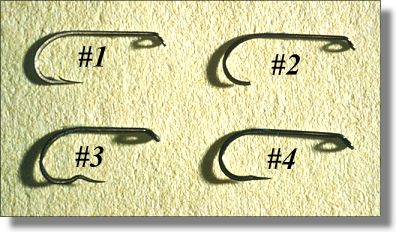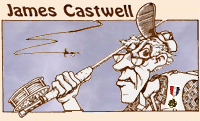|
A departure here from the norm. I came across this picture from thirty
years ago and decided to tell you why I took it. It was from a program I
did from the back of a wagon train, showed it on the side of a sleeping
buffalo. Well, OK, not that long ago, but almost.
 The hook (1.) is the one we start out with. The brand and number is not
here important, the shape is. It has a 'Point.' Either you buy them and tie
a fly on it, or you buy a fly with the hook included. We hope the hook remains
that way.
The hook (1.) is the one we start out with. The brand and number is not
here important, the shape is. It has a 'Point.' Either you buy them and tie
a fly on it, or you buy a fly with the hook included. We hope the hook remains
that way.
It also has a barb. What's that for? Be careful with your first answer,
it may be wrong. In fact, it probably will be. It is NOT to keep the fish on.
That is YOUR job. Don't argue with me here. It is your job. The barb is
a hold over from those made in days when bait was very popular. It is
to keep the WORM on!
So, with a barb on a hook, you need some 'X' amount of pressure or pull
to drive the hook through (notice, I said THROUGH) the hard jaw of a fish.
Imagine if you had less diameter of steel to pull through. Suppose we
remove the barb. Now it will not take as much 'X' force to slip the hook
through. Are there advantages? Stand back. All kinds of them.
If it takes less 'pull' you should be able to get more fish hooked all the way
to the bend. That translates as BETTER HOOKING! How about this one?
You could use a lighter leader! Hey, if it takes less pull, you can go down one
tippet size. So what? The fly will drift more drag free! MORE HOOK-UPS! This
just keeps getting better and better. Pretty strong case here for a barbless
hook. Add this one. Which would you rather remove from the
back of your neck? Point made.
Need more? There is more. The hook at (2) is how many of your hooks look
after some fishing. Real hard to catch fish with one, but you have and might
still continue fishing with one like that. Your comment will resemble, "Wow,
the fish actually broke the hook!" Ya, right. He did if you did not get
COMPLETE penetration. What happens is this: The fish hits and you pull,
the hook does not go in PAST the barb. It gets stuck there. With that leverage
and the angle of pull, the weakened barbed hook will break. If you had gone
in past the barb, it would not have happened. May not seem important, it
will only happen on a big fish with a hard mouth.
The other thing which happens is you can knock the end off a barbed hook by
hitting a branch or a rock on a cast, or pulling it back from a snag. A snagged
fly certainly does not go in past the barb, just the point gets stuck. The
result is the hook at (2). Pinching down or filing the barb off is not the best
answer either, better than nothing, but not the best. The best would be hook (4).
It is made without a barb. No weakness here.
While I am at it, take a look at the dismal representation of the 'hook-makers'
art at (3). What a failure. Absolutely worthless if your object is to hook anything.
When a line is attached to the eye and pulled, the point turns nearly 90 degrees
to the eye. Instead of hooking it simply tries to open. We did many tests on hooks
and fish and even made prototypes for penetration. It failed every thing we tried.
Stupid design.
Let's wrap this up. Use barbless, buy barbless, fish barbless, get more hits, get
better penetration, lose less fish, protect your own person, your flies will last
longer, and oh yes . . .
The fish will enjoy the game more too! ~ JC
|







